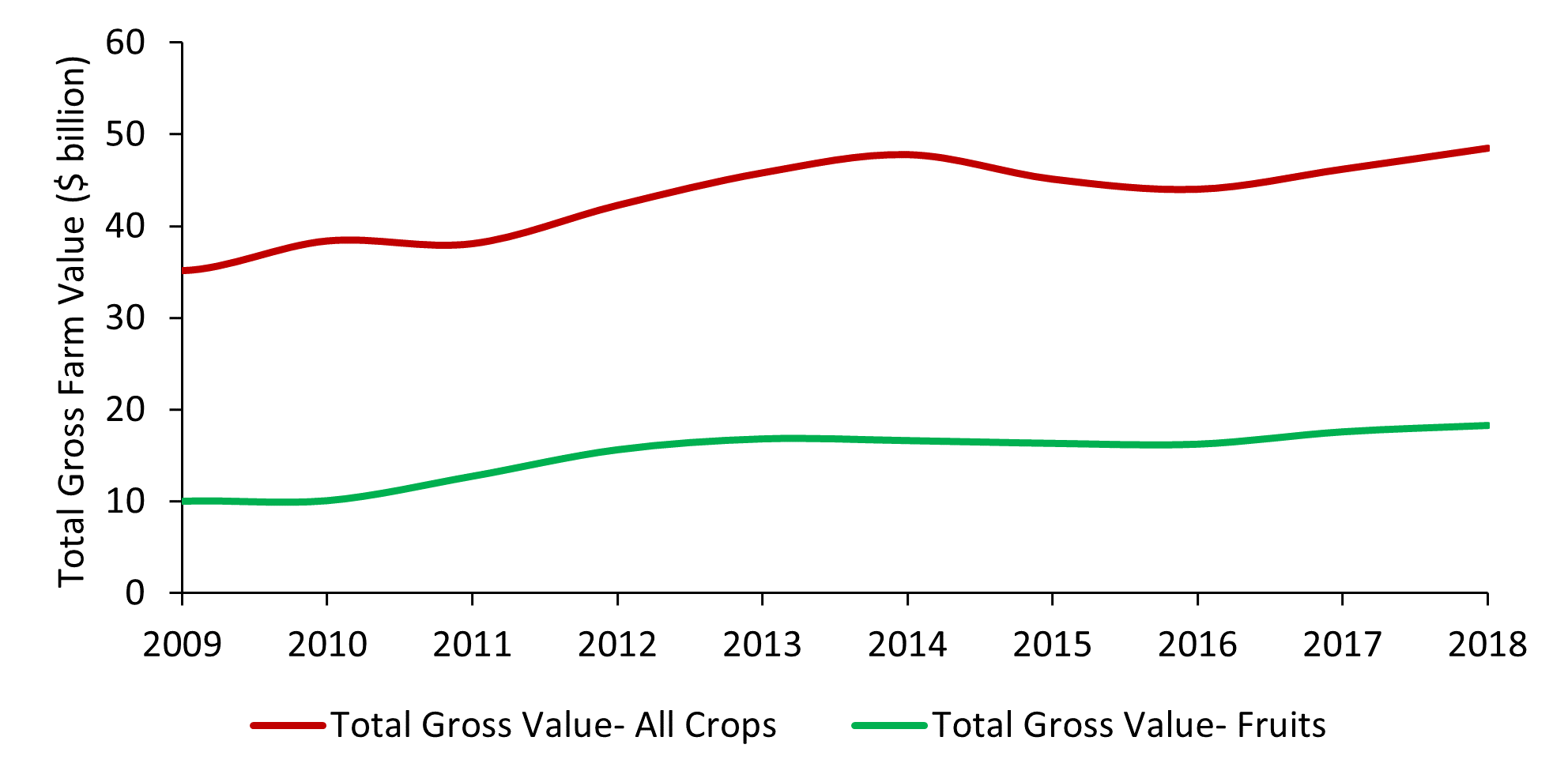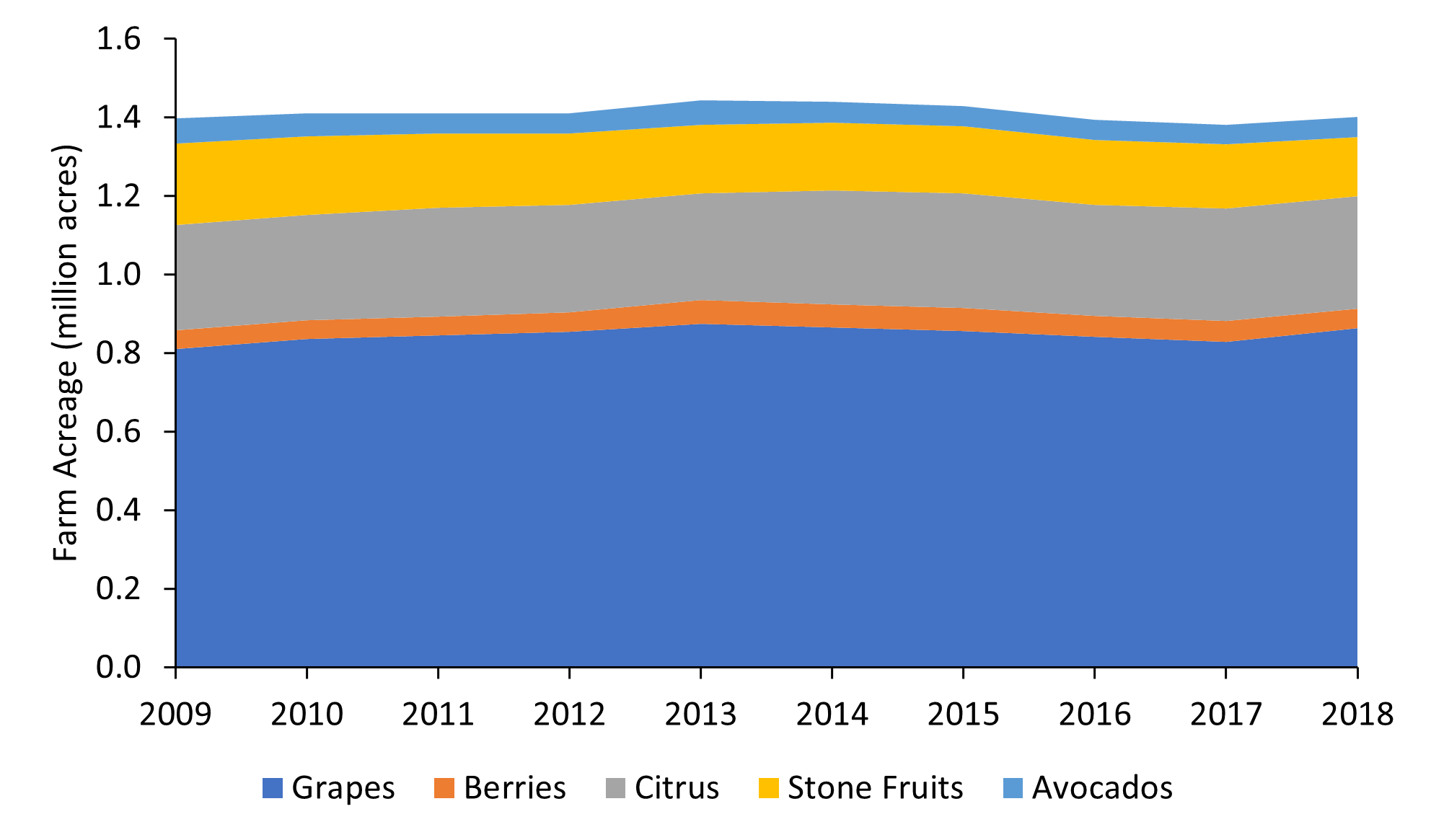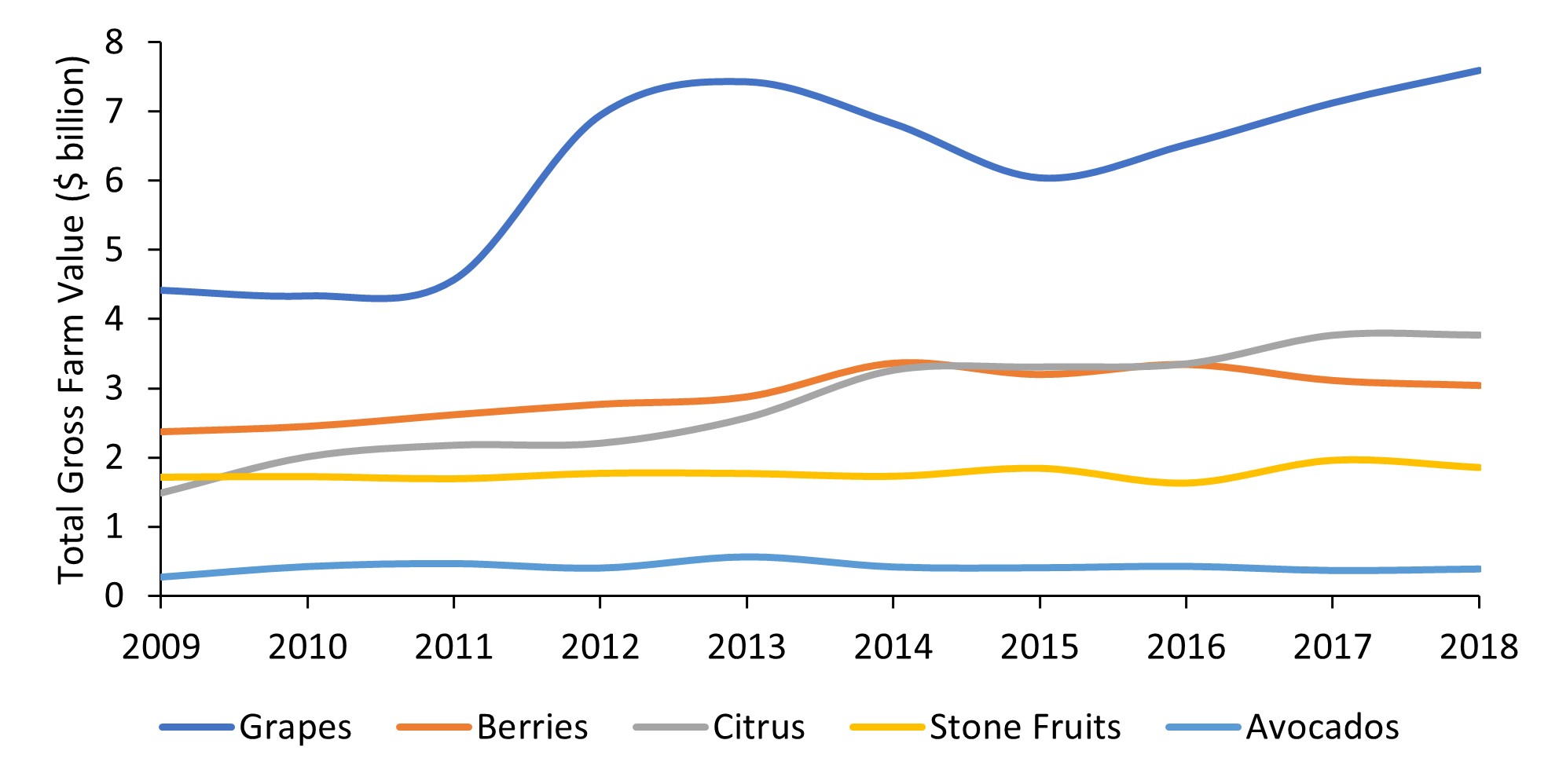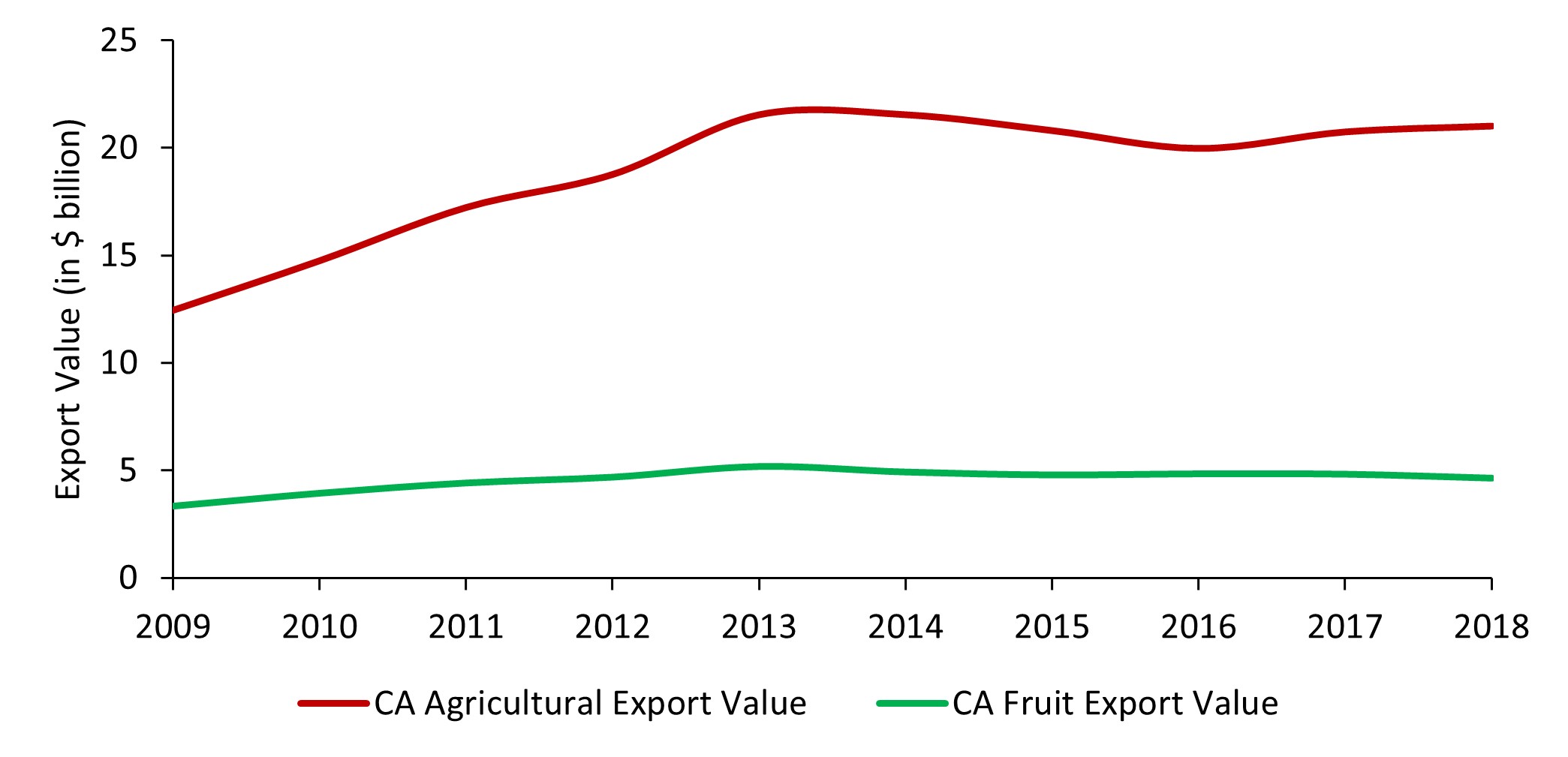
The value of fruit production in California has grown to over $18 billion, making up to two-thirds of the total value of U.S. fruit farming in 2018. This increase provides consumers a variety of fruits available all year around; however, Americans’ daily fruit consumption is still lower than the level recommended in the 2015–2020 Dietary Guidelines for Americans. Fruit farming receives minimal assistance relative to commodity crops, but Farm Bill supports reducing farming risks and government programs encouraging more fruit consumption have gradually increased in recent decades.
| Commodity Group | Total Value (in $1000) | Percentage |
| Fruits | 18,242,251 | 37.63% |
| Nuts | 10,691,252 | 22.06% |
| Vegetables | 9,825,213 | 20.27% |
| Field and seed | 5,872,205 | 12.11% |
| Nursery products, flowers, and foliage | 3,842,385 | 7.93% |
| All crops | 48,473,306 | 100.00% |
Note: Following the USDA's classification, this study includes melons in the category,
not the fruit category.
Source: CDFA (2020b).
California fruit growers must now deal with issues that raise their production costs and decrease their farm revenue significantly. The main issues noted by the California Fresh Fruit Association (2020) are water curtailment, groundwater requirements, immigration policies, labor regulatory compliances, invasive pests, and food safety compliance. However, opinions on how to solve issues tied to: water, environment, immigration and labor policies are very diverse. Unprecedented drought conditions over 2011–2017, increasing levels of soil salinity, and political polarization further compound these problems. We summarize California fruit farming trends and analyze current and potential issues affecting the sector by assessing factors related to trade, policy, labor, water access, climate, pests and disease, and financial risks.

Source: CDFA (2020b).

Source: CDFA (2020b).

Source: CDFA (2020b).

Source: CDFA (2020a).
Among U.S. states, California receives the highest total gross farm value for all commodities. Fruit production accounts for 37.6% of California’s total gross farm value (Table 1). Figure 1 demonstrates the changes in total gross value of all crops and fruit faming from 2009 to 2018. In the last decade, gross farm value increased from $35.2 billion to $48.4 billion, while fruit production values increased from $9.9 billion to $18.2 billion. Total fruit acreage has fluctuated around 1.5 million acres in California since 2009 (Figure 2). Nevertheless, we witness a noticeable decline in stone fruit, raisin, and orange acreages, while wine grape, berries, and mandarin acreages have increased. Although this study does not analyze the reasons behind these changes, we note that demand and new markets are often major factors for growers switching to new crops.
California is commercially the sole producer of six fruits (dates, figs, raisin grapes, kiwifruit, olives, and clingstone peaches) and leads other U.S. states in the production of 22 other fruits (CDFA, 2020b). In this study, we divide selected high-value fruits into five major categories: grapes (wine, raisin, table, and others), citrus (oranges, tangerines, grapefruits, and lemons), berries (strawberries, raspberries, and blueberries), stone fruits (peaches, nectarines, prunes/plums, apricots, and cherries), and avocados. Figure 3 shows the gross farm value of production of selected fruits in California. Grape farming in California creates over $7 billion in value. Berries and citrus are worth above $3 billion each, followed by $2 billion in stone fruit production statewide. Avocado, olive, and apple/pear production are valued at $0.7 billion. In 2012, a sharp increase in unit prices for table and wine grapes significantly raised the total farm value for grapes, which is attributed to the grape shortage resulting from a growth in demand (Bailey, 2012).
The value of Californian fruits utilized for domestic consumption has exhibited sustained growth, from $10 billion in 2009 to $13 billion in 2018. California also leads the nation in expanding fruit exports, from $3.4 billion in 2009 to $4.7 billion in 2018 (Figure 4). The value of California fresh fruit exports is one-fourth of its total agricultural exports though it may not grow further because of increasing domestic demand. Half of the fresh fruits consumed domestically consist of imported fresh fruits—mainly bananas, avocados, table grapes, and berries, valued in 2018 at $2.2 billion, $2.4 billion, $1.6 billion, and $2.9 billion, respectively—which makes the United States a net fruit importer since 1970s (Johnson, 2016). Moreover, per capita U.S. fruit consumption has not changed significantly in past decades and experienced a small decline from 254 pounds in 2009 to 241 pounds in 2018 (USDA, 2020). Therefore, we suggest that the growth in demand is mainly driven by U.S. population increase.
Fruits are an important part of a healthy diet and have been shown to reduce the risk of many chronic diseases, such as type 2 diabetes, some cancers, and obesity (CDC, 2018). The 2015–2020 Dietary Guidelines for Americans recommend that adults should consume 1.5–2.0 cups of fruit per day. However, CDC surveys in 2015 show that only 12.2% of respondents met the daily fruit intake recommendations (Lee-Kwan et al., 2017). Federal programs such as Food and Nutrition Service nutrition programs and the fresh fruit and vegetable program encourage all children and adults regardless of their sociodemographic groups to consume more fruits.
The USDA also provides assistance to producers and marketers of fresh fruits. Federal Crop Insurance and Disaster Assistance programs reduce yield risk, Market Access and Technical Assistance for Specialty Crops programs help producers access foreign markets, Federal Marketing Orders standardize grade and quality, and several specialty crop grants and farmers’ market programs support research and promotion.
California fruit growers, however, deal with many issues resulting from federal policies and state regulations. Based on the California Fresh Fruit Association’s annual top-ten issues list, the main issues repeatedly facing the fruit industry in the past few years include groundwater regulation, water supply availability, immigration policies, changing labor standards, food safety compliance, and invasive pest issues (CFFA, 2020). This study estimates the potential impact of these issues on the fruit industry based on previous impact studies (Babcock, 2018; Bolda, Goodhue, and Zalom, 2010; Bovay, Ferrier, and Zhen, 2018; Howitt et al., 2015; Martin, Hooker and Stockton, 2017; Richard, 2018; Sunding and Roland-Holst, 2020). Table 2 reports the expected impact of these issues.
| Issues in Fruit Farming | Issue Caused By | Expected Impact | Current Level | Percentage Impact |
| 1 | 2 | 3 | ||
| Water curtailment | Shrinking snowpack in Sierra Nevadas and drought | >36,000 fallow acres | 1,500,000 acres | >2.4% decline in acreage |
| Groundwater regulation | Sustainable Groundwater Management Act | 260,000 fallow acres | 1,500,000 acres | 17.3% decline in acreage |
| Labor shortage | Federal immigration policies | $500 million additional labor cost | $2.3 billion labor cost | 22% increase in labor cost |
| Labor regulation | California minimum wage law | $390 million additional labor cost | $2.3 billion labor cost | 17% increase in labor cost |
| Invasive Pests | Invasive pests | |||
| Berry/cherry farming | $600 million farm value reduction | $3.3 billion gross value | 20.0% loss in farm value | |
| Citrus farming | $740 million farm value reduction | $3.7 billion gross value | 20.0% loss in farm value | |
| Food Safety | U.S. Food Safety Modernization Act | $240 million additional cost | $18 billion revenue | 1.32% cost of compliance decreased from revenue |
| Trade disruption | Retaliatory tariffs on U.S. products | $190 million export revenue loss | $4.7 billion export value | 4% decline in U.S. agricultural export value |
Note: Expected impact calculated by authors. Dollar amounts are at the 2018 level. Percentage impact (column 3) is calculated by dividing the value in column 1 by the value in column 2.
The snowpack from the Sierra Nevadas is a crucial water source for fruit growers. The runoff from melted snowpack replenishes reservoirs during dry months in California’s San Joaquin Valley (SJV), where most of California’s tree fruits are produced. More of the precipitation falls as rain rather than snow due to warmer winters in the past few years; as a result, the reservoirs cannot contain all the runoff water for later months. In the last decade, California has also suffered a long-term drought, which has further limited allocation of water to SJV growers.
Combined with drought and La Niña years, water service contractors in the SJV have received ever-declining water allocations of their contract total. Howitt et al. (2015) estimate that the drought and limited water allocation may result in the fallowing of over 36,000 acres of orchards and vines. Since total fruit farming in California is about 1.5 million acres, we estimate at least a 2.4% decline in total land dedicated to fruit farming.
The Sustainable Groundwater Management Act (SGMA), which will take full effect by 2040, provides a framework for long-term sustainable groundwater management in California. The SGMA requires water agencies to halt overdraft and bring groundwater basins into balanced levels of pumping and recharge. This state regulation may lead some growers to pull their land from agricultural production or keep their land fallow. Sunding and Roland-Holst (2020) suggest that the SGMA may lead to a decline of 260,000 acres in harvested acreage for tree fruits and vines in the SJV, or 17.3% of California fruit acreages leaving production.
Over 60% of crop workers in California are unauthorized or undocumented (Martin, Hooker, and Stockton, 2017). Additionally, studies show that the rate of substitution between domestic and immigrant labor is fairly low, and it is not plausible to assume that wage-induced substitution will attract domestic labor into agriculture (Wei et al., 2019). Current immigration policies are removing unauthorized foreigners and limit H-2A guest workers, who are the significant workforce for U.S. agriculture. Therefore, farm labor shortages are becoming a severe problem in California. Another issue fruit farmers face is the rising cost of labor due to strict state regulations and increasing minimum wage. For instance, California minimum wage legislation set the new level to $15/hour by 2024, raising gradually from $10/hour in 2016 (Hill, 2018; Scheiber and Lovett, 2016).
California fruit and tree nuts establishments employ 100,000 full-time equivalent (FTE) employees, who receive around $3 billion total wage (Martin, Hooker, and Stockton, 2017). Richard (2018) suggests that removing 50% of undocumented farmworkers would increase the salary by 22% to replace them with domestic workers. IMPLAN (2017) data show that fruit farming employs three times more workers than does tree nut farming. Therefore, we assume 75,000 FTE employees in fruit farming, receiving $2.3 billion wage payment. Thus, the salary increase will account for additional $500 million annual labor cost for fruit farmers.
California fruit industry mostly employs seasonal farmworkers who generally receive minimum wage; Martin, Hooker and Stockton (2019) calculated a noticeable gap between the average earnings of FTE employees and the average earnings of actual farmworkers. The study reports that the primary workers share of FTE is 50% for all agriculture and 53% for fruit farming, but it does not provide a breakdown by employment type. Therefore, we assume that half of farmworker earnings have been paid to seasonal workers at minimum wage since 2016. At the new $15 minimum wage level, labor cost for California fruit farmers will increase by $390 million per year in 2018 price level.
California fruit production has suffered from invasive pests. For instance, the spotted wing drosophila (SWD) is a pest of berry and stone fruits first detected in 2008 in California and now found along the entire west coast of the United States. Another well-known pest problem in California is Asian citrus psyllid, a vector of the bacterial disease Huanglongbing (HLB), also known as citrus greening (Warnert, 2012). HLB has caused devastating damage in Florida, infecting 80% of citrus trees (Singerman and Useche, 2016). In California, HLB was first detected in 2012. Current and possible invasive pests have become one of the biggest concerns for fruit growers.
Bolda, Goodhue, and Zalom (2010) estimate that SWD may cause 20% yield reduction in berry and cherry production in California. We calculate a $660 million decline in gross crop value for berry and cherry farming given $3.3 billion total value of these fruits in 2018. Babcock (2018) assumes that Asian citrus psyllid invasion and HLB could reduce citrus yields by 20%. Based on our calculations, we expect to see a $740 million decline in gross production value.
The food safety modernization act (FMSA)—the first-ever food safety requirements for farms producing fruits and vegetables, established science-based standards for growing, harvesting, packing, and holding produce—will be fully implemented by 2024 for small and very small businesses (FDA, 2019). The FMSA established many produce rules, including for agricultural water quality, soil amendments of animal origin, worker health and hygiene, animal intrusion, sanitary standards, and record-keeping requirements (Bovay, Ferrier, and Zhen, 2018).
| Farm Size | Area Operated | Average Sales Value | Number of Farms |
| Very Small | 1.0 - 69.9 acres | $59,319 | 24,742 |
| Small | 70.0 - 139 acres | $378,948 | 3,359 |
| Large | ≥140 acres | $2,428,893 | 6,986 |
Source: USDA (2017).
Fruit growers are generally small or very small farms, and the costs of complying with the FMSA have already begun to impact fruit growers. Table 3 shows that there are 24,742 very small, 3,359 small, and 6,986 large farms in California (USDA, 2017). The Agricultural Census reports the size of fruit and nuts farms by acreage. The table combines several farm sizes into three general ranges based on total annual average sales: very small farms (1.0–69.9 acres and <$250,000 average sales); small farms (70–139 acres and <$500,000 average sales); and large farms (>140 acres and >$500,000 average sales). Bovay, Ferrier, and Zhen (2018) estimate that the cost of compliance with FSMA for California fruit and vegetable producers will be 1.32% of their revenue. We estimate that, by 2024, fruit growers in California may bear additional costs of $240 million.
Export markets provide opportunities for fruit growers to expand their market opportunities. Favorable export prices may also increase growers’ revenues and improve crop quality and grade. However, China recently imposed retaliatory tariffs on U.S. fresh and processed fruits. The USDA projects a 4% decline in U.S. agricultural exports due to continuation of these tariffs (Regmi, 2019). If conditions persist, we estimate an annual loss of $190 million in export revenues when we apply a 4% decline to California fruit exports.
California will remain the largest fruit growing state in the United States due to its favorable climate and farmers’ expertise in fruit production. However, industry growth might halt due to strict state regulations and federal policies. Since government programs aim to increase per capita intake of fruits, California fruit growers might require additional assistance to tackle the many issues that increase their production costs and decrease their revenue. The industry might benefit from innovative research and promotion programs, which can decrease production costs and open new markets which will allow fruit industry to reach consumers from all demographics. The industry would benefit highly from expanded crop insurance programs, favorable farm labor and immigration policies, export promotion and market expansion efforts, and incentives for agricultural research and development.
Babcock, B.A. 2018. Economic Impact of California's Citrus Industry. Visalia, CA: Citrus Research Board.
Bailey, P. 2012, September 25. “California Wine Industry on Upswing Despite Grape and Labor Shortages, Survey Finds.” UC Davis News. Available online: https://www.ucdavis.edu/news/california-wine-industry-upswing-despite-grape-and-labor-shortages-survey-finds/.
Bolda, M.P., R.E. Goodhue, and F.G. Zalom. 2010. “Spotted Wing Drosophila: Potential Economic Impact of a Newly Established Pest.” ARE Update 13(3): 5–8.
Bovay, J., P. Ferrier, and C. Zhen. 2018. Estimated Costs for Fruit and Vegetable Producers to Comply with the Food Safety Modernization Act's Produce Rule. Washington, DC: U.S. Department of Agriculture, Economic Research Service, EIB-195, August.
California Fresh Fruit Association. 2020. Top 10 Issues, 2019. Fresno, CA: CFFA. Available online: http://www.cafreshfruit.org/top-10-issues.
California Department of Food and Agriculture. 2020a. California Agricultural Exports, 2018-2019. Sacramento, CA: CDFA, California Agricultural Production Statistics. Available online: https://www.cdfa.ca.gov/statistics/PDFs/AgExports2018-2019.pdf.
California Department of Food and Agriculture. 2020b. California Agricultural Statistics Review, 2018-2019. Sacramento: CDFA, California Agricultural Production Statistics. Available online: https://www.cdfa.ca.gov/statistics/PDFs/2018-2019AgReportnass.pdf.
Centers for Disease Control and Prevention. 2018. State Indicator Report on Fruits and Vegetables. Washington, DC: CDC. Available online: https://www.cdc.gov/nutrition/downloads/fruits-vegetables/2018/2018-fruit-vegetable-report-508.pdf.
Hill, A.E. 2018. “The Minimum Wage and Productivity: A Case Study of California Strawberry Pickers.” Paper presented at the annual meeting of the Applied and Agricultural Economics Association, August 2–7, Washington, DC.
Howitt, R., D. MacEwan, J. Medellin-Azuara, J. Lund, and D. Sumner. 2015. Economic Analysis of the 2015 Drought for California Agriculture. Davis, CA: University of California, Davis, Center for Watershed Sciences.
IMPLAN Group, LLC. 2017. IMPLAN Database. Huntersville, NC: IMPLAN.
Johnson, R. 2016. The U.S. Trade Situation for Fruit and Vegetables Products. Washington, DC: Congressional Research Service, CRS Report to Congress RL 34468, December.
Lee-Kwan, S.H., L.V. Moore, H.M. Blanck, D.M. Harris, and D. Galuska. 2017. “Disparities in State-Specific Adult Fruit and Vegetable Consumption-United States, 2015.” MMWR Morbidity and Mortality Weekly Report 66(45): 1241–247.
Martin, P., B. Hooker, and M. Stockton. 2017. “Employment and Earnings of California Farmworkers in 2015.” California Agriculture 72(2): 107–113.
Martin, P., B. Hooker, and M. Stockton. 2019. “Ratio of Farmworkers to Farm Jobs in California Increased to 2.3 in 2016.” California Agriculture 73(2): 73–78.
Regmi, A. 2019. Retaliatory Tariffs and US Agriculture. Washington DC: Congressional Research Service, CRS Report to Congress R45903, September.
Richard, T.J. 2018. “Immigration Reform and Farm Labor Markets.” American Journal of Agricultural Economics 100(4): 1050–1071.
Scheiber, N., and I. Lovett. 2016, March 28. “$15-an-Hour Minimum Wage in California? Plan Has Some Worried.” The New York Times.
Singerman, A., and Useche, P. 2016. “Impact of Citrus Greening on Citrus Operations in Surveying the Florida Citrus Survey-based Estimates on HLB.” University of Florida, Gainesville: University of Florida Institute of Food and Agricultural Sciences Publication 98300.
Sunding, D., and D. Roland-Holst. 2020. “Blueprint Economic Impact Analysis: Phase One Results.” Berkeley, CA: University of California, Berkeley, Working Paper. Available online: https://www.restorethedelta.org/wp-content/uploads/SJV-Blueprint-for-Extinction-Economic-Study-2-15-2020.pdf.
U.S. Department of Agriculture. 2017. Census of Agriculture. Washington DC: U.S. Department of Agriculture, National Agricultural Statistics Service. Available oline: www.nass.usda.gov/AgCensus/.
U.S. Department of Agriculture. 2020. Food Availability (per capita) Data System. Washington, DC: U.S. Department of Agriculture, Economic Research Service. Available online: https://www.ers.usda.gov/data-products/food-availability-per-capita-data-system/.
U.S. Food and Drug Administration. 2019. FSMA Compliance Dates. Washington, DC.: U.S. Food and Drug Administration. Available online: https://www.fda.gov/food/food-safety-modernization-act-fsma/fsma-compliance-dates.
Warnet, J. 2012. “Asian Citrus Psyllid and Huanglongbing Disease Threaten California Citrus.” California Agriculture 66(4): 127–130.
Wei, X., G. Önel, Z. Guan, and F. Roka. 2019. “Substitution between Immigrant and Native Farmworkers in the United States: Does Legal Status Matter?” IZA Journal of Development and Migration 10(1).